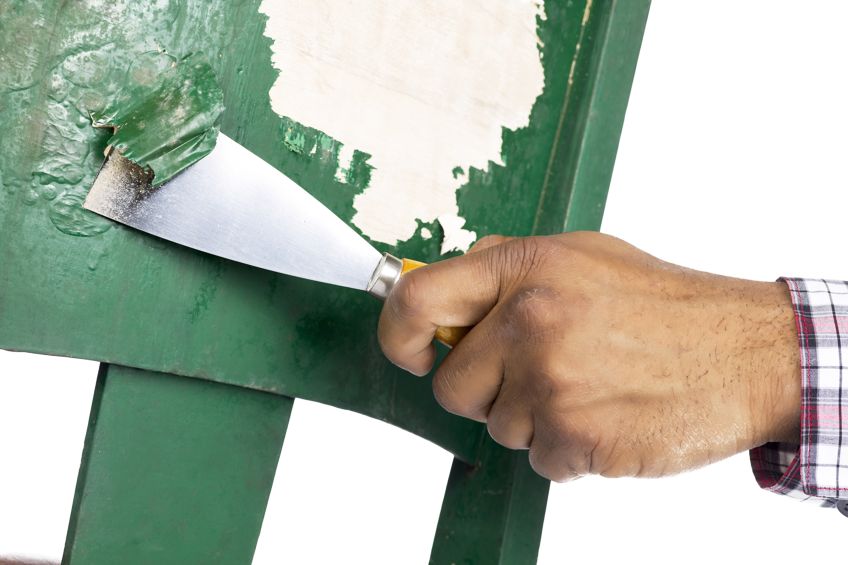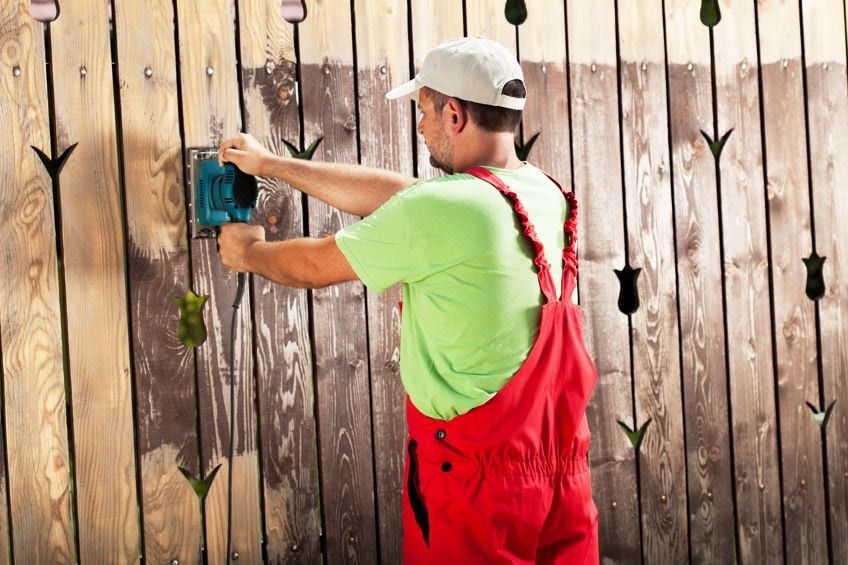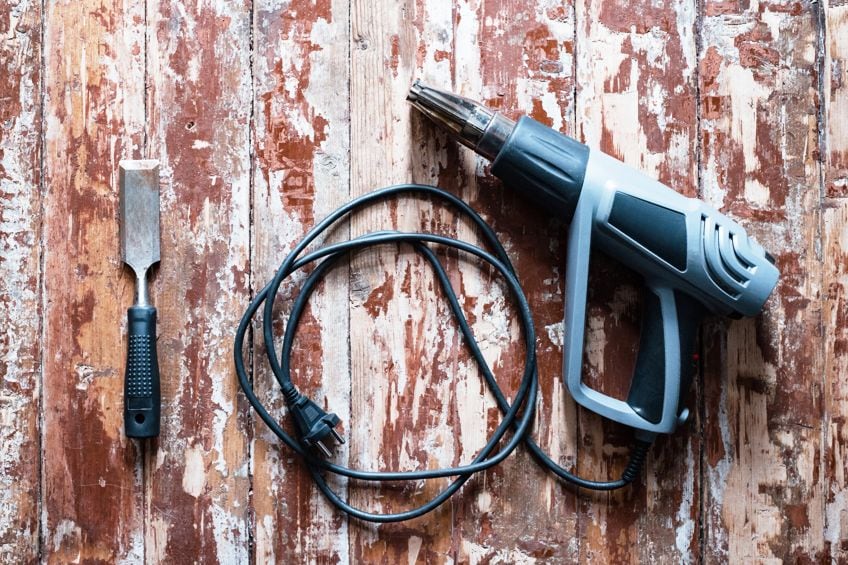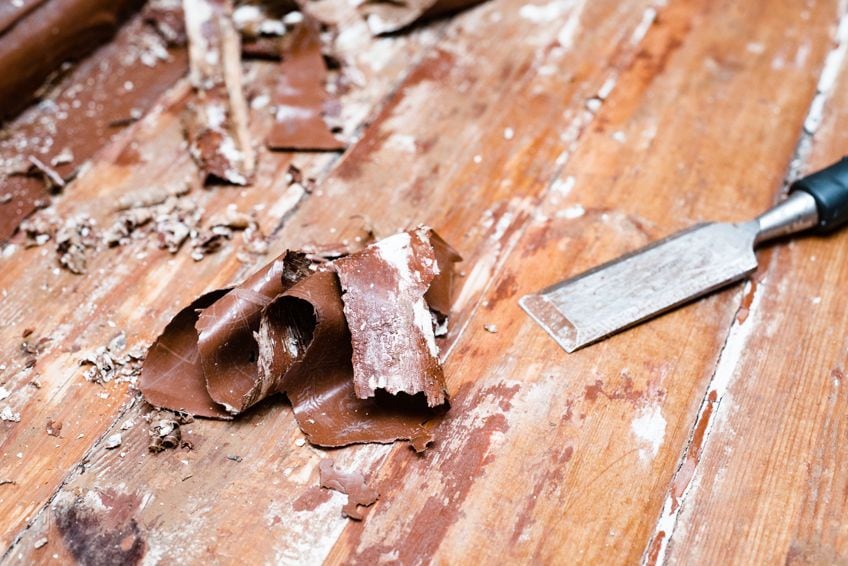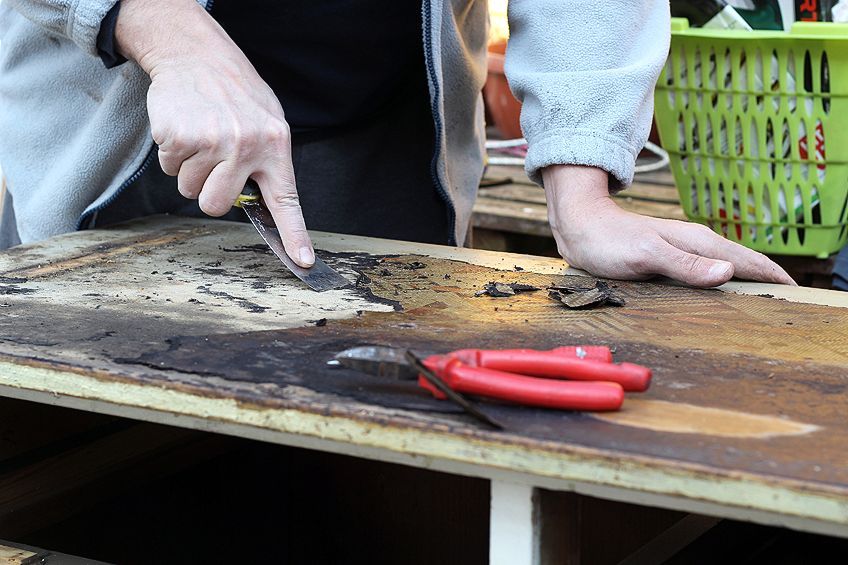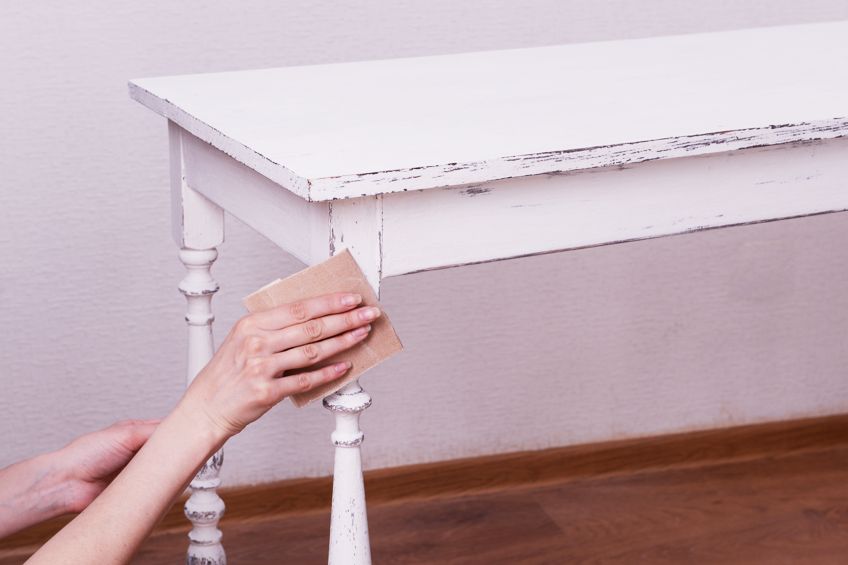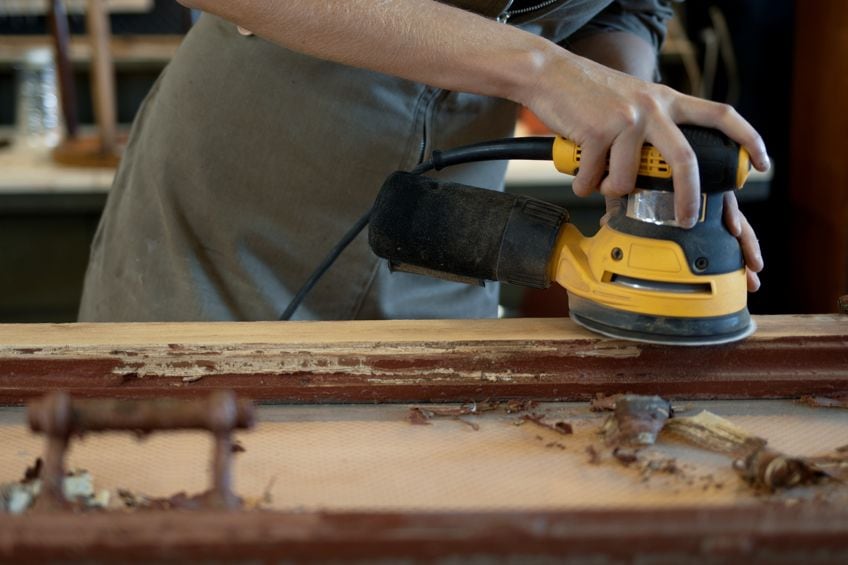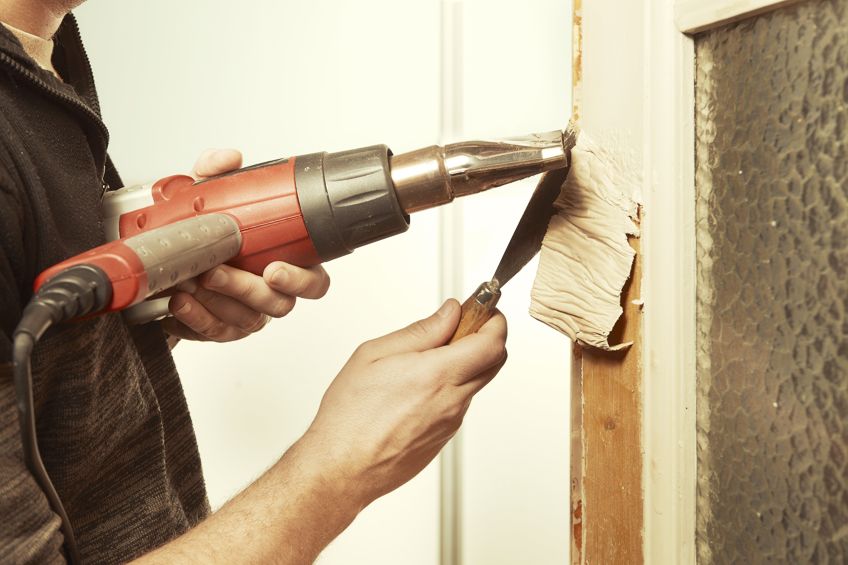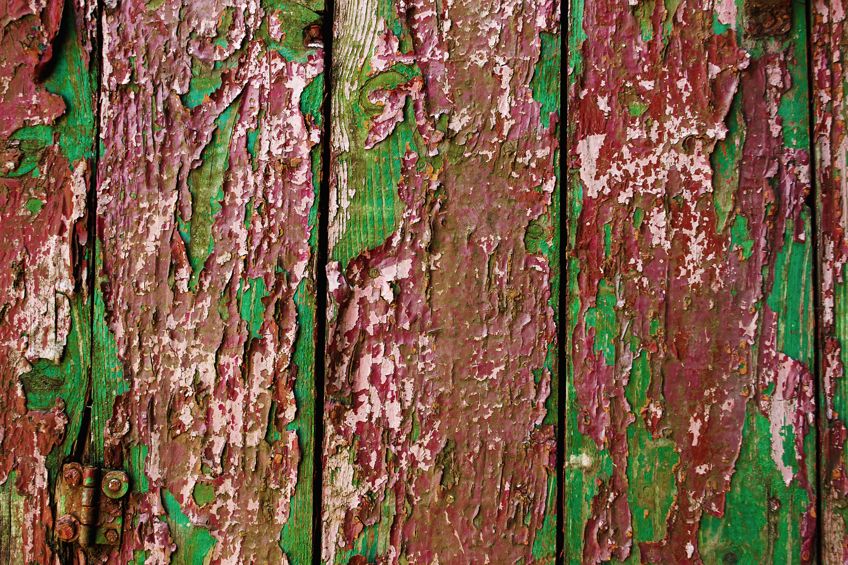How to Remove Paint From Wood – A Guide to Stripping Woodwork
This post may contain affiliate links. We may earn a small commission from purchases made through them, at no additional cost to you. You help to support resin-expert.com
Picture this: You have just bought your dream home, but the house needs a bit of tender love and care, and by that, we mean a serious paint job! The rustic look works for a short while, before the peels of old paint start littering your floors, causing shabby appeal. This tutorial is all about how to remove stubborn paint from various kinds of wood and the easiest way to strip paint off wood. We will cover all the instructions on removing paint from wood, including the easiest way to strip paint from wood and the best way to remove paint from wood. Some of you might be completely clueless when it comes to stripping woodwork, so we will discuss some of the best paint strippers for wood products that are available on the market. So, if your home is in need of a bit of revamping, keep reading for a step-by-step guide on how to strip paint from wood.
Table of Contents
Different Wood Types You Can Remove Paint From
There is nothing worse than the way paint looks when it starts to peel and chip away. This usually happens after years of wear and tear or weather damage. It does not matter whether the wood is in a particular position, like vertical or horizontal, stripping woodwork for most types of wood is very possible, and a worthwhile effort. Here are some examples of the different surfaces you can learn how to strip paint from wood:
- Reviving antique furniture
- Stair railing or banisters
- Floors like parquet or oak boards
- Skirting boards
- Doors and window frames inside and outside
- Patio furniture
- Outdoor decking
- Mantle pieces and window sills
- Cupboards
The act of giving your home a new paint job is not for the lazy or faint-hearted. It is a laborious but rewarding job. This is mainly due to the fact that the old layer of paint must be removed so that the surface looks new. This way the chipping pieces of the old layer will not lift up and start to cause the new layer to peel too early, and it will make sure your surface is still flush when you are done.
Things to Consider Before Removing Paint From Wood
There are a few things that must be considered before you start with your paint remover for wood. There is nothing worse than starting a project and then realizing you made a mistake somewhere along the line. In order to prevent damages when using a paint stripper for wood, we have a few suggestions for you to keep in mind.
Is the Wood Worth Stripping?
The temptation to save money can be amazingly hard to resist. Give the wooden item a good once over and make sure there are no rotting points. You might think that with good sanding the rot will go away, but, it is a deceiving thought! This is because the rot is contagious with wood and it will spread until the whole item starts decaying in unsalvageable ways.
You can identify if there is rot on your wooden furniture by feeling whether the surface is spongy or not. Press your finger into the surface and see if it is hard like the wood is meant to feel, or damp and spongy.
If you are working with a wooden floor, you might be able to remove certain floorboards of wood that have started to rot and leave the healthy ones. This is also achievable with parquet flooring. Use a paint scraper on an area of the wooden floor that is the least noticeable, and see what condition the wood is underneath.
Test the Old Paint for any Lead Content
Lead is very toxic to us humans, and it should be taken into serious confederation. Most of the older houses that have not had a new paint job since the 1960s will have paint that contains lead. There are various methods you can choose to test for lead in the paint that is simple to apply from the comforts of your home.
- Send it to the Laboratory. This might take some time because you might have to wait up to t weeks for the test to be processed and the results sent back to you. It may promise reliable results, but the time it takes may not be for everyone.
- Call in a Profession to do the job. There are companies that specialize in stripping paint from wood, and they have certain devices that will take an X-ray reading of the paint and they will find out whether or not it contains lead.
- Use a knife to cut a “V” shape. This is the most simple version of tests for lead in your paint. Cute the shape of a “V” in the old paint and then you can see if there is lead in the paint by brushing a lead-check swab that you can buy at your local paint supply store.
Once the tests have come back as a positive, you know that you need to be more cautious when removing the paint than you would if there were no lead in the paint. We have a few suggestions on how to remove paint from wood if there is lead in the paint.
- If you are working outside, always lay down a sheet of plastic over the floor space that you are working on. This will prevent any of the chemicals from destroying the ground underneath.
- The lead will release some poisonous fumes and dust if you use heat or chemical-based formulas to remove the paint.
- Make use of the wet-sanding process so that you can prevent as much of the dust from being breathed in.
- Make sure that the tools you use when sanding (if it is unavoidable) are set to a high-efficiency particulate air filtration system.
Decide if a Professional Is Needed
Sometimes it is okay for us to take a step back and admit that we need a little help from time to time. There are people who specialize in paint jobs, which include using paint remover for wood. They have the right tools and experience, so sometimes, the easiest way to strip paint from wood is by calling in a professional.
Remove Any Screws and Nails
If there are some nails that are poking out from the surface, you will need to remove them before you start, because the best way to remove paint from wood is occasionally via sanding, and it will be a much more difficult task if there were obstacles in the form of building materials in your way.
Get all Necessary Equipment Ready
The most annoying thing about DIY projects is realizing when you are halfway through the job that you are missing an important piece of equipment or a certain material needed for an efficient job done. Professionals would come with everything they need, but if doing it yourself, you will have to make sure that you have gathered your tools and materials beforehand so that you do not have to run off to the supply store mid-way through the job.
Choosing a Paint Stripper for Removing Paint from Wood
There are a few methods for removing paint from wood, but the best way to remove paint from wood is relative to a few simple variables. If you are wondering how to remove paint from wood, like your kitchen cupboards or wall panels, then keep reading.
Using Industrial Products as Paint Strippers
Sanding down the wood can be quite a laborious task, the process requiring some elbow grease and stamina. Sometimes the original coat of paint was done in layers which makes it quite difficult to remove, holding onto the wooden surface.
In this case, there are other methods that involve the use of chemical-based products that are highly effective and the best way to remove paint from wood if it is stubbornly holding onto the surface.
Most chemical paint removers should be able to reach the places that a sander would not because the liquid can be poured over the area you wish to remove the paint from. The paint will be easier to scrape away with a paint scraper once it has been applied and left for a minute or two.
Solvent-Based Paint Strippers
Solvent-based paint strippers are highly effective because of the number of chemicals in their solutions. There are, of course, different strengths in solvent-based paint strippers, ranging from high doses of chemicals, to quite low. This allows you to use the paint strippers even if the type of wood you are removing the paint from is a delicate type. If you are working indoors, make sure to have ample ventilation, so keep your windows and doors open.
PROS
- Will not damage the wooden surface because you can choose different strengths
- Leaves a clean and smooth finish
- Will not discolor the wood even though it is so effective
- This is ideal to use for that natural wood appeal
- Highly effective paint remover for wood
CONS
- Heavy paint may be difficult to remove
- Not very affordable
- Intense smell
Caustic-Based Paint Strippers
Caustic-based paint strippers are much more affordable than solvent-based paint strippers, this along with the fact that it can remove heavier layers of paint and it actually works much faster than solvent-based paint make it the more sought-after option. If there are other chemicals in the wood present, there may be a reaction with the caustic elements in these products that may scorch or stain the surface.
PROS
- Easily strips paint from intricate designs on the wooden items
- More affordable than solvent-based products
- Less of an odor than solvent-based products
- Able to strip thick and heavy coats of paint
- Caustic products are the most suitable for pine wood
CONS
- May stain or scratch the wooden surface if there are other chemicals that react to the caustic elements
If the planet is a concern for you, and you would prefer to use eco-friendly products that have less volatile organic compounds, or VOCs. These will come as a citrus base or even a soy base.
Our Recommended Paint Remover Brands
There are hundreds of different paint removers that you can find all over the world from online shops and physical stores. All of the various products promise so many different results and efficiencies that it might be a difficult choice to make for some of you.
For your benefit, we have compiled a list of our favorite products that you can choose from. We have recommended these products because they are made by reputable brands, and have reliable reviews. Each one of these products comes in a small quantity, so if you are still unsure after reading this, you can buy a sample of each and try out their effectiveness.
Best All-Round Paint Stripper: DUMOND SmartStrip Advanced Paint Stripper
Dumond is one of the most reputable brands in the industrial and even the commercial industries, a truly trusted brand when it comes to the easiest way to strip paint off wood. They have a paint stripper that is highly effective in stripping oil-based paints and latex-based paint from wooden surfaces, as well as various other surface materials like fiberglass, metal, plastic, brick, and plaster. This is a biodegradable and eco-friendly product because it is water-based. Regardless of that fact, it is very efficient and is able to remove up to 15 coats of paint at a time with one small application.
- The non-toxic formula is safe for the user and the environment
- A highly effective solution removes multiple layers with a single-use
- Does not contain methylene chloride, any caustics, or toxic chemicals
The consistency of the paint is almost like a paste, which can easily be smeared over vertical surfaces without it running down. It only needs to sit on the painted surface for about 15 minutes for the product to activate and do its job. You can then scrape off the paint with your choice of steel wool, paint scraper, or a wire brush. Be careful not to scratch the surface of the wood with the wire brush or the steel wool.
PROS
- Works with both oil-based and latex-based paint
- Works on various surfaces
- Non-carcinogenic
- Removes up to 15 coats of paint
CONS
- Often needs more than one application
Best Heavy-Duty Paint Stripper: DUMOND Peel Away Stripper
Stripping paint from your antique furniture is made easy with Dumond’s peel-away paint stripper. It can also help you to remove the paint from any ceiling roses, detailed mantle pieces, cornices, and more. The consistency of the paint is also like a paste, like the advanced paint tripper mentioned above, but it needs between twelve and forty-eight hours to effectively strip the paint.
The efficiency of this product is quite amazing – once you have waited for the right amount of time for the product to dissolve the paint, it manages to strip away up to thirty-two coats of paint with one application of the product.
- Water-based, zero VOC, and produces no harmful odors or fumes
- Removes up to 32 layers of paint in one application
- Safest method to remove lead paints by eliminating lead and dust
PROS
- Removes up to 32 coats of paint
- Single application
- Produces no harmful odors or fumes
- Can be used on most indoor and outdoor surfaces
CONS
- Takes a lot of time
Least Harmful Paint Stripper: CITRISTRIP Aerosol Paint and Varnish Stripper
Citristrip not only has a catchy name and leaves this amazingly satisfying smell of citrus when applied, but it is a very effective paint stripper. It is an oil-based product that works particularly well when removing latex-based paints and varnishes, shellac, or polyurethane finishes. It is applied as a spray but has a consistency that gives you a 24-hour period to remove the paint because the formula remains active during that time frame.
- Stays wet and active for up to 24 hours to strip multiple layers
- Removes dried oil and latex paints, varnish, lacquer, and more
- Strips multiple layers from wood, metal, and masonry surfaces
PROS
- Affordable
- Biodegradable
- Able to use indoors
- Aerosol spray can makes application easy
- Methylene chloride and NMP (N-Methylpyrrolidone) free
CONS
- Needs a lot of ventilation
- Does not strip a high amount of paint layers
- Less adhesion than other removers
How to Apply Chemical-Based Industrial Paint Strippers
Understanding what is the best type of paint stripper for wood that is of an industrial or chemical nature, you can start to learn how to use these products. As always, make sure that you have your most suitable protective gear like a respiratory mask and gloves so that the chemicals do get into your lungs, or better yet, work in an outside workspace that has a plastic tarp laid down to protect the floor. See below for the list of tools and materials you will need when stripping woodwork.
- Safety eye mask
- Respiratory mask
- Protective gloves
- Clothing protector apron
- Cloths
- Old paintbrush
- Putty knife
- Steel wool or a brush with wire bristles
- Paint scraper
- Big bucket
- Sandpaper
- The solvent or caustic-based product for removing paint from wood
It is important to get all of the equipment you may need together before you start so that you do not need to make any unnecessary trips to the supply store halfway through. Once all of your tools and materials are gathered everything you might need and adorned yourself in your protective gear, you can begin.
Read on for instructions on how to strip paint from wood and the easiest way to strip paint off wood!
- Your first step is to give the surface a bit of sanding down. This will roughen and soften the surface of the paint that they are trying to remove and this will allow the product to sink in better.
- Next, give your paint remover of choice a good shake before you apply it. This will get all of the chemicals to mix together nicely with better efficiency.
- You cannot pour the solution over the area you wish to remove the paint from. Also, do not forget to replace the lid once you have finished pouting because these types of paint removers will evaporate quickly otherwise.
- Make sure that you are pouring enough of the remover, as too little will not be as efficient as you need. When you start scraping the paint, make sure you work in one direction with the scraper or the steel wool.
- Sometimes the eco-friendly paint strippers are not as effective when simply applied. If you wrap the area in plastic wrap it will make it more effective because you can leave the paint stripper to do its job over a period of 24 hours without it evaporating.
- If the space you are removing the paint from is quite large, we suggest starting with smaller spaces than trying to pour enough product to cover the whole space. Pouring too much at first will be a waste of the product because most of it will evaporate before you can get to it.
- If you are working with a caustic or solvent-based paint stripper, you can leave it to sit on the layer of paint you are removing for about twenty minutes before you start to scrape the paint away. This will allow the chemicals to sink in and loosen the paint from the wooden surface. Sometimes a product might have a different time for the activation process, so make sure you read the label carefully for any particular instructions. Be wary that you do not leave it on the surface for too long so as to avoid damaging the wooden surface.
- You will know if the paint is ready to be scraped off when it is soft to the touch. Dried paint is usually quite hard, but the chemicals will start to break down the hardened paint so it can easily be removed. If you need to wait longer than twenty minutes, then so be it. Always wait for the paint to have softened before you start to scrape so that you do not damage the surface you are working with. Use some steel wool, a wire brush, or a paint scraper.
- The best way to remove paint from wood that has intricate carvings, you can pour the paint stripper, wait twenty minutes as you would for a flat surface, then use a toothbrush to work away from the paint
- Once the old and ugly layer of paint has been removed, you can start to think about replacing it with varnish or adding a new and fresh coat of paint. Read the label of the paint stripper you used to remove the paint for any specifications stating that the wood must be neutralized before you add any new layers of paint.
Once that has been done you can sand down the surface lightly to roughen it up for a better grip on the new coat of paint and clean up the debris from the sanding before you apply the new coat.
Other Methods for Removing Paint from Wood
There are a few other ways to get paint off of wood, if you do not have any of the products above at hand, you could try using a more natural method or sanding instead. Here are some other ways to easily remove paint from wood.
Using Household or Natural Products to Strip Paint From Wood
When it comes to old wives’ tales that our grandmothers and grandfathers would preach to use, vinegar was one of the most versatile in use and most effective liquids. It can also be used as a home remedy for removing paint from wooden surfaces. Not only is it effective, but it is also friendly to the environment because it is a natural product. Here is how you can use vinegar to remove the paint from your wooden surface:
- The first step is to heat up the vinegar by putting it in a pot on the stove and heating it up slowly.
- The second step is to dip your cloth into the war vinegar and then use it to rub the paint until it starts to strip off the paint from the surface
- Sometimes you will have to leave the vinegar on the surface for up to fifteen minutes for it to sink in and break down the paint.
- Once the paint has started to feel soft you can use a paint scraper to scrape it off.
- Once you are finished you can wash the surface of the vinegar with some soap and water
Using Sandpaper to Remove the Old Paint
Sometimes the layers of paint that you are trying to remove might not be as old as you might think and you will struggle to remove it with a liquid. Paint that is stubborn and difficult to remove will benefit from a good sanding down.
If you are working with a large area, you might want to invest in an industrial machine for sanding. The sanding method may not be the easiest way to strip paint from wood, but it is definitely the most effective in removing the most stubborn layers of paint – all you need is some elbow grease!
You just need to make sure that you apply the right amount of pressure with the sandpaper, and not too much, so that you do not damage the surface you are working with.
If you do not have a machine sander, or if the space is small enough to be done by hand, you can use your hands to hold the sandpaper. The perfect grit for removing paint would be a coarse sheet of sandpaper with a grit of about eighty. Once the paint has been removed, you can start with finer sandpaper with a grit of 220, for the smoothing out of your surface once again. See below for the different examples of sanders.
| Type of Sander | Different Uses and applications |
| Disc Sander Machine | Ideal for smaller surfaces because of tier smaller size and easy application |
| Belt Sander machine | Ideal for larger areas. They are able to remove heavy and rough material from the surface |
| Finishing Sanding Machine | This is more ideal for once the paint has been removed and you are adding the refining and smoothing out the surface |
| Orbital sanding machine | These sanders have just as much power as the disc sander but are not suited for big jobs |
One thing to remember is that you must test the original coat of paint to see if it contains any lead. This can be done with lead-testing swabs that you can buy from any paint supply shop. If the paint does have lead in it, then you must be very careful when sanding the surface down for the dust particles will be toxic because of the dead.
If you find that sanding the paint off is needed because no other methods will work, then make sure you make use of the wet-sanding method.
If you use a sanding machine to strip the paint from your wooden surface, then we have some suggestions for you to make it an easier process. These tips will come in handy, especially if you are a newbie to this area of expertise.
- There is a method called hook and loop that you can use to attach the piece of sandpaper to the machine. Make sure that the grit of the sandpaper is appropriate for the task
- Once the sandpaper has been attached you can switch on the power. First test the sander on a smaller not noticeable section to make sure it will not cause damage
- Once you start sanding the paint from the wood surface, always go in one smooth motion, following the direction of the grain
Using Heat to Remove Paint
When all chemicals fail, heat will do the trick! Applying heat to most applications for a lot of DIY and industrial projects makes it far more effective – like washing dishes in hot water vs cold. This method is effective in removing those stubborn patches of paint, and it is able to remove a few layers at a time.
If there is lead in the paint, you must be cautious because there will be toxins present in the fumes the heat causes. You can protect yourself with a repository mask so that you do not breathe them in. Here are some of the different methods for applying heat that you can try out.
Hot Air Guns
Hot air guns or hot air blowers are very versatile tools to have on hand, for a wide range of reasons, including drying out paint layers and even removing paint from wooden surfaces. The best hot air gun to use is one that has a few strings of heat ranging from low to high.
In order to effectively remove paint from a wooden surface using a hair air blower, you need to make sure you find the perfect temperature that is high enough to actually soften the dried paint and low enough not to scorch the wooden surface.
The trick to using heat as a paint tripper is to never keep the hot air fixed on one spot for too long, rather keep it moving continuously, about two inches from the surface. Once the paint has softened you can use a paint scraper to peel and scrape the paint away.
Steam Paint Remover
This is a highly effective method of applying heat to remove paint from a wooden item. The mixture of the moisture that is released at a temperature of about 212 degrees Fahrenheit makes the paint soften and peel off easily. We are careful that you do not make the wooden surface soggy by holding the steamer in one place for too long.
Infrared Tools
This is definitely the most intricate and effective way to strip paint. The infrared is so easy to use, without making any mess, or any noise for that matter. This method is far more controlled, keeping the temperature at a steady 500 degrees Fahrenheit, and it will have less chance of damaging the surface with scorch marks.
One added bonus is that the next layer of paint you apply will adhere much better because the infrared also absorbs the moisture from the wood.
Removing Paint via Sandblasting
Sandblasting promises some remarkable abilities in stripping paint from any kind of wooden surface. A sandblaster is a nifty machine that has a high-pressure outlet where it literally blasts sand at your wooden surface which effectively strips the paint right off. Here are some of the benefits you can appreciate by choosing this method.
- You are not restricted to any specific sized project because sandblasting machines will work for large or small projects.
- If you have a patch of very stubborn coats of paint, a sandblaster will be their demise.
- Most of the time a professional is needed to complete the job via sandblasting, therefore you can relax. There is nothing better than not having to worry about messing it up and relying on the strengths of a professional
- Sandblasting is friendly to the environment, using only sand and a high-pressure system and leaving out all chemicals like with methods that use solvent or caustic-based products.
- This method goes quite quickly because of the efficiency of the machine but it will not damage the wooden surface either.
We have spoken about so many different methods, all of the words might be swimming around in your head, causing some intense confusion. We decided to simplify things for you and we have put everything we have spoken about in a simple table of comparison. See below a summarized description of abilities and uses for the different methods of removing paint from wooden surfaces.
| Sandpaper for Stripping Paint from Wood | Heat for Stripping Paint from Wood | Chemical-Based Paint Removers | |
| Fast Acting | ✘ | ✔ | ✔ |
| Simple Application | ✘ | ✘ | ✔ |
| Messy | ✔ | ✘ | ✔ |
| Safe Application | ✔ | ✔ | ✔
(Only Water-based Products) |
| Affordable | ✔ | ✔ | ✘ |
Tips and Tricks for Removing Paint From Wood
To finish off, we have compiled a list of our final tips to help you with your paint removal. If you would prefer to avoid making a mess of the job by letting the different strippers mess everywhere, then this will be your favorite section.
- Make sure that you choose the correct product for the specific type of paint that was used for the coat you are trying to remove.
- Make sure you read the label for any specifications
- When you are working outdoors, lay down a sheet of plastic to protect the ground from any of the chemicals you may use to remove the paint.
- Gather all the necessary tools and equipment before you start so that you have minimal interruptions whilst you work
- Work at a slow pace, rather than in a hurry. If you rush through you might make a mistake or damage the surface of the wood.
- Make sure that you have enough safety gear to protect your eyes, lungs, and skin, particularly if you have sensitive skin.
- If you are working indoors, make sure you have enough ventilation
- You are only finished once you have cleaned up the area you have been working in.
After our comprehensive article, we are sure you will have all the know-how on how to effectively remove paint from wood. We hope that you find all of this information on removing paint from wooden surfaces helpful, and we wish you luck in your endeavors and DIY projects!
Frequently Asked Questions
What Is the Easiest Method for Stripping Paint From Wood?
This depends on the number of coats that the original paint job was done with. Typically, if you use chemicals, you will have a more effective experience with removing the paint, but you might also find that the paint may need a machine like a sandblaster or a power sander.
How Can I Avoid Damaging the Wood Surface When Stripping Paint From It?
You can avoid damaging the surface of your wood by taking care when you are using a paint scraper, wire-bristle brush, or a piece of steel wool.
Is Vinegar Good for Stripping Woodwork?
Vinegar is a highly effective and very versatile product that can be used for many different jobs. It is a great cleanser, and it can also be used to remove paint from multiple surface materials, including wood. It works by softening the paint so that it can be scraped away with a paint scraper.
Are Heat Guns Effective as a Paint Stripper for Wood?
If you use heat as a method for removing paint from a wooden surface, then you must make sure to read our instructions and tips to make sure you do not cause any damage by applying too much heat in one concentrated area for too long.
Is There an Environmentally Friendly Paint Remover Available?
If you prefer to use products that are less harmful to the planet, there are water-based or citrus-based products that are effective in removing paint from wood, and they leave a pleasant aroma if you work, unlike solvent-based products.
What Method Can I Use to Remove Oil-Based Paint From a Wood Surface?
Caustic or solvent-based products will have a good reputation amongst professionals for removing most types of paints, including oil-based paints from wooden surfaces, but not all types of wood are compatible with these solutions because of the highly chemical base. Maple wood has a tendency to get a blackened mark where the solvent touched it. If you are trying to remove oil-based paint from the wooden surface in question, then you can look for products that are designed specifically for the purpose.


